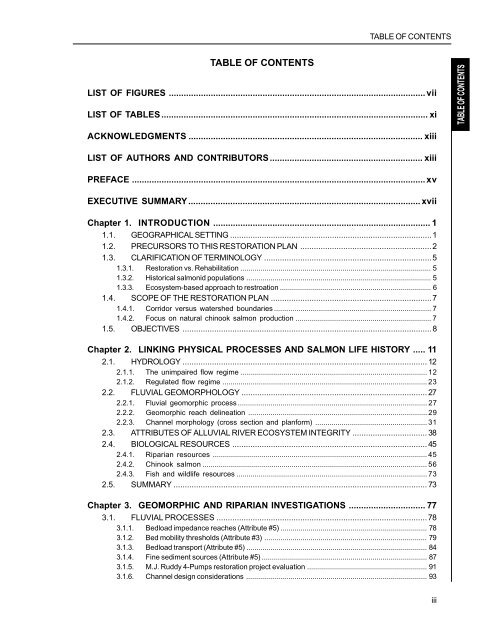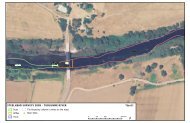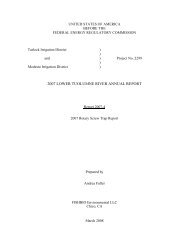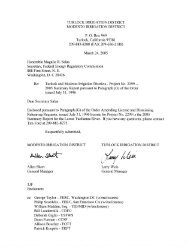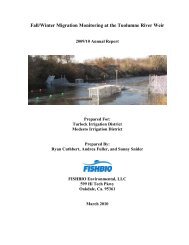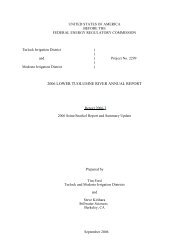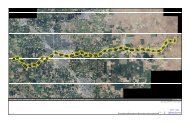Tuolumne River Report - U.S. Fish and Wildlife Service
Tuolumne River Report - U.S. Fish and Wildlife Service
Tuolumne River Report - U.S. Fish and Wildlife Service
You also want an ePaper? Increase the reach of your titles
YUMPU automatically turns print PDFs into web optimized ePapers that Google loves.
TABLE OF CONTENTSTABLE OF CONTENTSLIST OF FIGURES ........................................................................................................ viiLIST OF TABLES ............................................................................................................ xiTABLE OF CONTENTSACKNOWLEDGMENTS ............................................................................................... xiiiLIST OF AUTHORS AND CONTRIBUTORS .............................................................. xiiiPREFACE ....................................................................................................................... xvEXECUTIVE SUMMARY.............................................................................................. xviiChapter 1. INTRODUCTION ........................................................................................ 11.1. GEOGRAPHICAL SETTING .........................................................................................11.2. PRECURSORS TO THIS RESTORATION PLAN ..........................................................21.3. CLARIFICATION OF TERMINOLOGY ..........................................................................51.3.1. Restoration vs. Rehabilitation ............................................................................................... 51.3.2. Historical salmonid populations ............................................................................................ 51.3.3. Ecosystem-based approach to restroation ........................................................................... 61.4. SCOPE OF THE RESTORATION PLAN .......................................................................71.4.1. Corridor versus watershed boundaries ............................................................................. 71.4.2. Focus on natural chinook salmon production ................................................................... 71.5. OBJECTIVES ..............................................................................................................8Chapter 2. LINKING PHYSICAL PROCESSES AND SALMON LIFE HISTORY ..... 112.1. HYDROLOGY ............................................................................................................ 122.1.1. The unimpaired flow regime ............................................................................................ 122.1.2. Regulated flow regime .....................................................................................................232.2. FLUVIAL GEOMORPHOLOGY .................................................................................. 272.2.1. Fluvial geomorphic process ............................................................................................. 272.2.2. Geomorphic reach delineation ........................................................................................ 292.2.3. Channel morphology (cross section <strong>and</strong> planform) ....................................................... 312.3. ATTRIBUTES OF ALLUVIAL RIVER ECOSYSTEM INTEGRITY ................................. 382.4. BIOLOGICAL RESOURCES ...................................................................................... 452.4.1. Riparian resources .......................................................................................................... 452.4.2. Chinook salmon ............................................................................................................... 562.4.3. <strong>Fish</strong> <strong>and</strong> wildlife resources .............................................................................................. 732.5. SUMMARY ................................................................................................................ 73Chapter 3. GEOMORPHIC AND RIPARIAN INVESTIGATIONS ............................... 773.1. FLUVIAL PROCESSES .............................................................................................783.1.1. Bedload impedance reaches (Attribute #5) ......................................................................... 783.1.2. Bed mobility thresholds (Attribute #3) ................................................................................. 793.1.3. Bedload transport (Attribute #5) .......................................................................................... 843.1.4. Fine sediment sources (Attribute #5) .................................................................................. 873.1.5. M.J. Ruddy 4-Pumps restoration project evaluation ............................................................ 913.1.6. Channel design considerations .......................................................................................... 93iii


